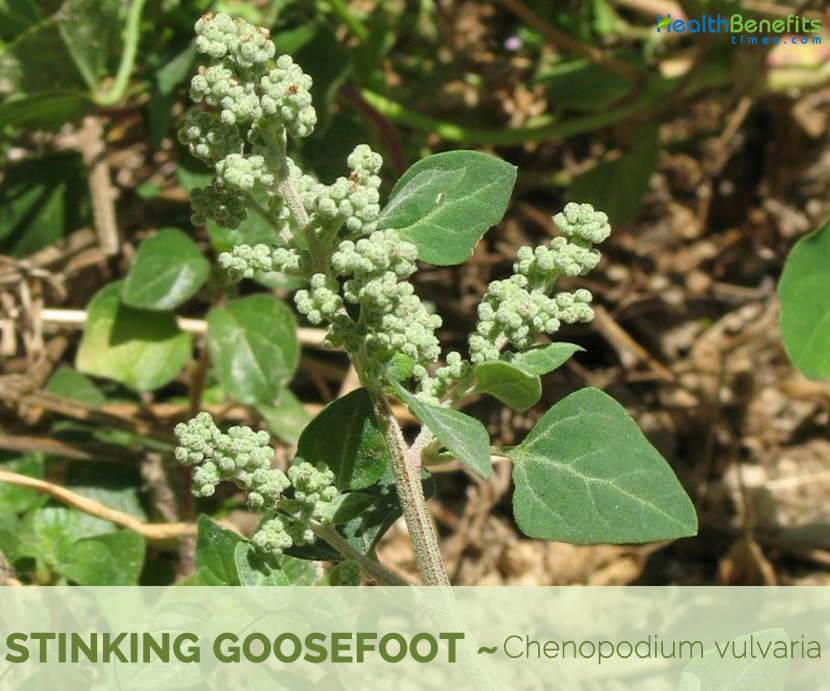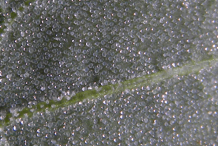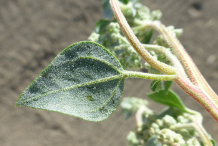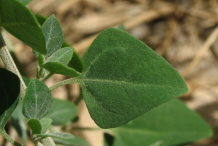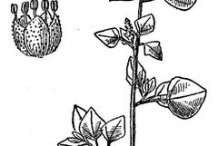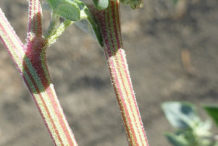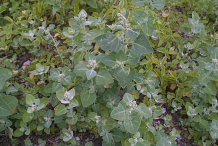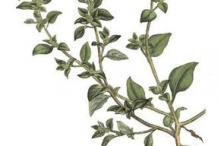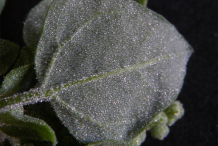Plant Description
Stinking goosefoot is a foul smelling annual Herb that grows about 10-60 cm tall. The plant is found growing along hedges, bushes (nutrient riches), caves on lime slopes, salt marshes, pebbly beaches, ruderale sites, mess corners at farms, fallow land, waste heaps, vegetable gardens, along roads and along walls. The plant prefers moderately moist, very nutrient-rich, usually highly fertilized, often calcareous, reprocessed soil (sand, marl and stony places). Stem is erect, much branched, spreading or ascendant and 5-10 cm long.
Leaves
The stalked leaves are oval, wedge-shaped at the base, about 1/2 inches long. Leaf blade grey-farinose especially beneath, greener above, longer than or equal to petiole, 0.5-3 cm long, broadly trullate or broadly ovate to ovate, margin entire, in large leaves sometimes with a fairly acute angle on each margin at broadest part, base truncate to short attenuate, apex obtuse to acute.
Flower & Fruit
Its small flowers are grouped in short inflorescences that are axillary and terminal. They have 5 farinaceous tepals that measure 0.5-0.8 mm in length, 5 stamens and a pistil. They usually open between June and October. There are no petals and the flowers are wind-fertilized. Its fruits are membranous, surrounded by the tepals and contain a single seed of dark brown and gleaming, which has a shape reminiscent of a casserole with its lid and measures 1-1.5 mm in diameter.
The whole plant is covered with a white, greasy mealiness, giving it a grey-green appearance which when touched, gives out a very objectionable and enduring odor, like that of stale salt fish, and accounts for its common popular name: Stinking Goosefoot.
Traditional uses and benefits of Stinking Goosefoot
- Whole plant is antispasmodic and emenagogue used to expel worms from the bowel.
- It is also used for the fungal infections and as a cardiac stimulant.
- It is a form of treatment for acute gout.
- An infusion of the dried leaves is used in the treatment of hysteria and nervous troubles connected with women’s ailments.
- In Chinese medicine wormseed oil is used for rheumatism, eczema and bites.
Culinary Uses
- Leaves and flower buds are cooked and used like spinach.
- Raw leaves should only be eaten in small quantities.
- Seed cooked and ground into a powder, mixed with wheat or other cereals and used in making bread etc.
Other Facts
- Seed is small and fiddly; it should be soaked in water overnight and thoroughly rinsed before it is used in order to remove any saponins.
- Gold/green dyes can be obtained from the whole plant.
Precautions
- People with a tendency to rheumatism, arthritis, gout, kidney stones or hyperacidity should take especial caution if including this plant in their diet since it can aggravate their condition.
- Wild arrach is not recommended in pregnant or breastfeeding women due to a lack of available scientific evidence.
References:
https://www.itis.gov/servlet/SingleRpt/SingleRpt?search_topic=TSN&search_value=20637#null
https://davesgarden.com/guides/pf/go/74004/
https://npgsweb.ars-grin.gov/gringlobal/taxonomydetail.aspx?id=10196
https://www.cabi.org/isc/datasheet/113243
https://www.botanical.com/botanical/mgmh/a/arrac059.html
http://www.pfaf.org/user/Plant.aspx?LatinName=Chenopodium+vulvaria
http://www.theplantlist.org/tpl1.1/record/kew-2717921
https://plants.usda.gov/core/profile?symbol=CHVU
https://en.wikipedia.org/wiki/Chenopodium_vulvaria
http://www.floracatalana.net/chenopodium-vulvaria-l-
Comments
| Stinking Goosefoot Quick Facts | |
|---|---|
| Name: | Stinking Goosefoot |
| Scientific Name: | Chenopodium vulvaria |
| Origin | Mountainous regions of Europe, North America and Asia |
| Shapes | Achenes depressed-ovoid; pericarp adherent, smooth |
| Health benefits | Used in the treatment of hysteria and nervous troubles connected with women's ailments |
| Name | Stinking Goosefoot |
|---|---|
| Scientific Name | Chenopodium vulvaria |
| Native | Mountainous regions of Europe, North America and Asia |
| Common Names | Stinking goosefoot, notchweed, Arroche Puante, Chénopode Fétide, Chénopode Puant, Arrach, Dog’s Arrach, Goat’s Arrach, Goosefoot, Herbe de Bouc, Netchweed, Oraches, Stinking Arrach, Stinking Goosefoot, Stinking Motherwort, Vulvaire |
| Name in Other Languages | Albanian: Minuer, nena e qelbët Arabic: Qayhanih (قيحانيه) Bulgarian: Strupeĭniche (струпейниче) Catalan: Blet pudent, Herba pudent, Pixacà, Vulvària Croatian: Smrdljiva loboda Czech Republic: Merl¡k smrdutì, merlík smradlavý Danish: Stinkende gåsefod Denmark: Stinkende gosefod Dutch: Stinkende ganzenvoet, stinkganzevoet, stinkmelde English: Arrach, Stinking goosefoot, Vulvaria, Dog’s orache, Watson’s goosefoot Estonia: Haisev hanemalts French: Chénopode fétide, Arroche puante, Chénopode puant, ansérine puante, herbe de bouc, vulvaire Finnish: Haisusavikka German: Stinkender Gänsefuß, Übelriechender Gänsefuss, Bocksmelde, Stinkkraut Greek: Louvoudiá (λουβουδιά) Hebrew: Kaf=’avaz mav’ishah, כַּף=אֲוָז מַבְאִישָׁה Hungarian: Büdös libaparéj, büdös libatop Italian: Atriplice puzzolana, brinaiola, chenopodio fetido, connina, farinello puzzolente Latvia: Dvokiancioji balanda, smirdošā balanda Lithuania: Silku balanda, balanda smirduolė, dvokiančioji balanda Moldavian: спанакпутурос Norwegian Bokmål: Sildemelde Nynorsk, Norwegian: Sildemelde Occitan: Poumbraio Polish: Komosa mierzliwa Portuguese: Erva-fedegosa, fedegosa, vulvária Romanian: Lobodă-puturoasă, spanac puturos Russian: марь вонючая, марь зловонная Slovak: Mrlík smradľavý Slovene: Smrdeča metlika Spanish: Cenizo fetido, cenizo hediondo, hediondilla, hierba hedionda, Meaperros, sardinera, vulvaria Swedish: Haisusavikka, Stinkmålla Turkish: Kokar sirken |
| Plant Growth Habit | Annual Herb |
| Growing Climate | Along hedges, bushes (nutrient riches), caves on lime slopes, salt marshes, pebbly beaches, ruderale sites, mess corners at farms, fallow land, waste heaps, vegetable gardens, along roads and along walls |
| Soil | Moderately moist, very nutrient-rich, usually highly fertilized, often calcareous, reprocessed soil (sand, marl and stony places). |
| Plant Size | 10-60 cm |
| Stem | Erect, very branched, spreading or ascendant, (5-10 cm long |
| Leaf | Leaf blade grey-farinose especially beneath, greener above, longer than or equal to petiole, 0.5-3 cm long, broadly trullate or broadly ovate to ovate |
| Flowering Periods | Jul to September |
| Flower | Small, insignificant green flowers are borne in spikes from the axils of the leaves and consist of five sepals, five stamens and a pistil with two styles |
| Fruit Shape & Size | Achenes depressed-ovoid; pericarp adherent, smooth |
| Flavor/Aroma | Nauseous odor |
| Seed | Compressed (1mm in diameter), black-brownish, shiny, acute margined, finely punctated. |
| Season | Aug to October |


